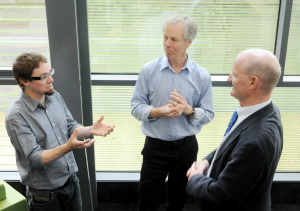by Dr Heath Murray
On June 27 the RH David Willetts MP, Minister for Universities and Science, visited the Centre for Bacterial Cell Biology (CBCB) to hear about how research on bacteria can lead to: development of novel antibiotics, design of synthetic biological systems, and even understanding the origins of life on earth. Dr Heath Murray (CBCB & ICaMB) tells us more about this visit.
Mr. Willetts was given a guided tour of the new Baddiley-Clark building by the director of the CBCB, Prof Jeff Errington.

Jeff (left) outlines CBCB research to David Willetts (right), with Heath (middle back) paying close attention
Jeff discussed why he left Oxford University after 25 years to start the CBCB at Newcastle, the first Centre of its kind in the UK to provide a world-class facility in which to carry out fundamental research on bacterial cells. During the tour Jeff highlighted how the localised network of international researchers at the CBCB, working on biological problems in model bacterial organisms provides an unparalleled setting in which to exchange ideas and to benefit from related advances in microbial cell biology. While walking around Jeff noted how the open plan of the Baddiley-Clark building promoted interactions amongst the various research groups, thereby creating a uniquely stimulating environment for the scientists that work there.
This was a very fruitful visit with interesting discussions, as highlighted by Jeff: “I was impressed at how quickly the Minister picked up the key biological points we wanted to make, such as about how our work impacts on thinking about the origins of life!”

An image similar to those seen by David Willetts showing severe DNA segregation defect in a mutant Bacillus subtilis strain, observed using epifluorescent microscopy. (DNA: blue; origin of replication: green, cell membrane: red)
I then demonstrated the bespoke microscopes available within the CBCB to the Minister, highlighting how the small size of bacterial cells (only a few micrometers) makes microscopic analysis technically challenging and how the CBCB is utilizing state-of-the-art super-resolution microscopes to overcome this difficulty. I also explained how researchers use genetic engineering to fuse their “proteins of interest” to the Green Fluorescent Protein (GFP) from the jellyfish Aequorea victoria, thus creating tools to visualize the localization of proteins or nucleic acids within living bacterial cells using fluorescence microscopy.
The Minister was keen to see the live demonstration of our fluorescent microscope and seemed amazed by how clearly the organization of the bacterial chromosomes was immediately apparent. He quickly appreciated that interfering with this process might have application in the development of new antibiotics.
We were all left with the clear feeling that Mr. Willetts enjoyed hearing about the science taking place within the CBCB and how this fundamental research provides insights crucial for the discovery and development of new antibiotics, as well as providing solutions to a wide range of industrial and environmental problems. “It was an interesting meeting – very reassuring to hear that the Minister is keen to make sure that Government continues to invest in Blue-Skies Research”, Jeff concluded.
Links
Centre for Bacterial Cell Biology: http://www.ncl.ac.uk/cbcb/
Department for Business, Innovation and Skills: https://www.gov.uk/government/organisations/department-for-business-innovation-skills
RH David WIllets MP: http://www.davidwilletts.co.uk/
Minister for Universities and Science: https://www.gov.uk/government/ministers/minister-of-state-universities-and-science-department-for-business-innovation-and-skills

